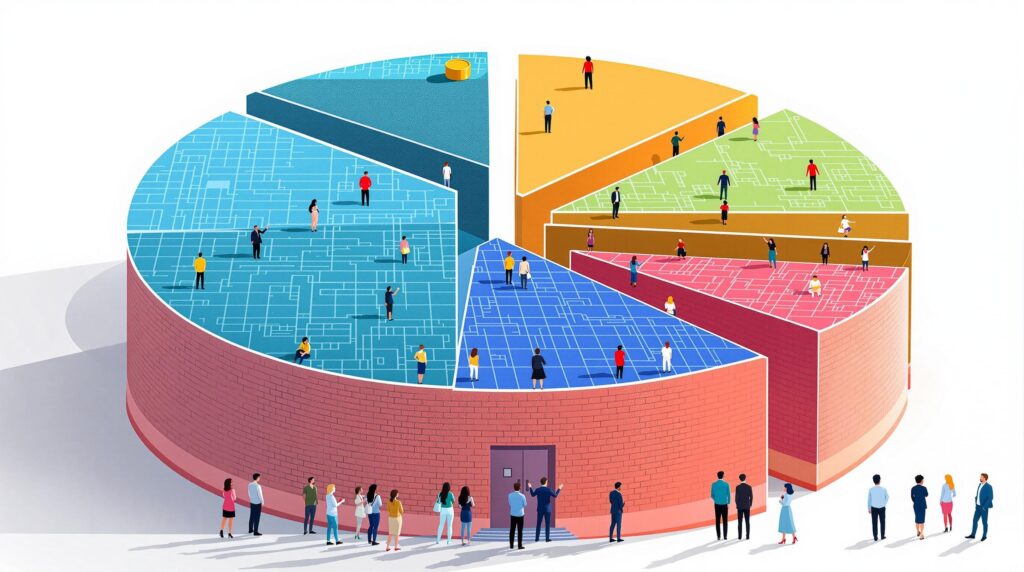[rev_slider alias=”slider-1″][/rev_slider]
Understanding Layer 1 Blockchains
Layer 1 blockchains form the backbone of the blockchain universe, serving as the primary network where all the transactions occur. Picture Layer 1 as the digital highways of the blockchain world, enabling vast flows of digital assets with security and precision. But what makes them so crucial? Let’s discover their significance in the blockchain ecosystem and why they are vital for secure transactions.
What is a Layer 1 Blockchain? A Layer 1 blockchain is the base level of a blockchain network, responsible for transaction validation, data security, and overall network governance. Its infrastructure facilitates secure peer-to-peer transactions and supports decentralized applications compatible with the network.
When we talk about Layer 1, it refers to the original blockchain architecture. It operates independently, unlike Layer 2 solutions, which are built on top of existing blockchain systems to enhance efficiency. Many of the well-known blockchains, such as Bitcoin and Ethereum, are Layer 1, providing the core structure on which other layers and applications can build.
Key Features of Layer 1 Blockchains
The importance of Layer 1 blockchains extends into various domains, from scalability to security and decentralization. These features ensure they are pivotal players in the evolving blockchain landscape, particularly for advancing cross-chain interoperability.
- Scalability: Layer 1 blockchains are constantly evolving to accommodate larger volumes of transactions. While early blockchains faced challenges with scaling, advancements like sharding and the Lightning Network promise to alleviate these issues. The aim is to process more transactions per second without compromising the network’s performance or security.
- Security: At the core of any blockchain is its security. Layer 1 blockchains employ consensus mechanisms like Proof of Work (PoW) or Proof of Stake (PoS) to secure the network, preventing tampering and fraud. These mechanisms ensure every transaction is verified, making it nearly impossible to alter transaction history.
- Decentralization: One of the foundational principles of blockchain technology is decentralization, and Layer 1 blockchains exemplify this. They operate without a central authority, ensuring transparency and reducing the risk of centralized control. This decentralization fosters trust among users globally, from Africa to other continents.
The interplay of these features enables Layer 1 blockchains to not only facilitate secure and decentralized transactions but also pave the way for cross-chain interoperability. This interoperability allows different blockchains to communicate, share value, and complement each other’s technological advancements, a vital leap toward a more interconnected and efficient blockchain ecosystem.
“Your Voice, Our Mission” – At Jara, we empower you to engage with Africa’s emerging digital asset economy securely, leveraging the revolutionary foundation of Layer 1 blockchains.
Layer 1 blockchains form the ground on which Layer 2 solutions build more efficient, faster systems. The technologies of Layer 1, enriched with constant innovation, hold the promise for a future where blockchain maintains its integrity, scales significantly, and fosters a networked world where cross-border transactions become seamless and commonplace.
To explore more about how these foundational technologies can be leveraged for practical applications like the tokenization of real-world assets, delve into Jara’s unique position in fueling Africa’s digital revolution here.
The Mechanics of Cross-Chain Interoperability
In the increasingly interconnected world of blockchain technology, cross-chain interoperability plays a vital role. But what exactly is it? Imagine trying to communicate in a room full of people speaking different languages. Without an interpreter, understanding would be impossible. Similarly, cross-chain interoperability acts as the ‘interpreter’ among distinct blockchain networks, enabling them to ‘speak’ to each other effortlessly.
This capability is no longer just a technical novelty but a necessity. As the blockchain landscape grows, with diverse Layer 1 and Layer 2 solutions like Jara’s proprietary ecosystem, the demand for communication between these disparate systems has surged. This connectivity is crucial for facilitating smooth transactions and data sharing across chains, which in tandem supports the burgeoning digital asset economies such as those in Africa.
Technologies Enabling Interoperability
Technological advancements underpin cross-chain interoperability. Central to this are protocols, smart contracts, and consensus mechanisms, each serving a distinct purpose in enhancing blockchain communication.
- Protocols: Think of these as the common ‘language’ protocols that allow blockchains to interface securely and effectively. These include solutions like interledger protocols, which facilitate transactions across different networks.
- Smart Contracts: These self-executing contracts with the terms directly written into code ensure that conditions are met across different blockchain environments, acting as reliable ‘gatekeepers’ of cross-chain agreements.
- Consensus Mechanisms: In cross-chain interoperability, consensus mechanisms are pivotal in ensuring data integrity and synchronicity across platforms. They serve as the checks and balances, enabling transactions to be validated consistently across multiple networks.
The role of Layer 1 solutions in this ecosystem cannot be overstated. These foundational layers provide the raw throughput and security necessary for seamless integration, much like a highway network that supports a multitude of different vehicle types, all traveling to their destinations without hindrance.
How does cross-chain interoperability work? It functions by utilizing protocols, smart contracts, and consensus mechanisms to facilitate communication and transactions between different blockchain networks, fostering a truly interconnected blockchain environment.
As Africa stands on the brink of a digital transformation through projects like Jara, the prowess of cross-chain interoperability becomes even more critical. By bridging global capital to African assets, Jara’s platform appeals to investors by offering access to a $200 billion market potential. This is not just about financial transactions but represents a new wave of economic empowerment and inclusion. The $JARA token exemplifies this by empowering users to invest in Africa’s infrastructure through tokenized projects, thus unlocking new streams of economic potential.
In conclusion, cross-chain interoperability is not just a technological buzzword but an essential mechanism for advancing the global blockchain infrastructure. From enabling intricate financial instruments to simplifying user interactions, it’s a key driver for future innovations in digital asset management, especially in emerging markets poised for robust growth.
[rev_slider alias=”text-call-cta”][/rev_slider]
Advantages of Layer 1 in Cross-Chain Solutions
Layer 1 blockchains, often referred to as the foundational layer of blockchain technology, play a crucial role in enhancing cross-chain interoperability. By providing a robust, decentralized platform, they offer remarkable advantages in terms of efficiency, security, and scalability that are indispensable for seamless cross-chain solutions. But what exactly are these advantages, and how do they manifest in real-world applications?
Efficient processing: Layer 1 blockchains streamline processes through their decentralized nature, reducing need for intermediaries and improving transaction speeds.
The first major advantage of Layer 1 blockchains is efficiency. These blockchains process transactions directly on the main chain, ensuring that they are swift and do not suffer from significant delays. This efficiency is particularly crucial for cross-chain solutions, where transactions need to be executed swiftly and accurately to maintain trust across different blockchain ecosystems.
Security is another significant benefit offered by Layer 1 blockchains. By operating in a completely decentralized manner, these blockchains provide a level of security that is unmatched by traditional systems reliant on centralized control. Decentralization eliminates single points of failure, which are typically vulnerable to attacks or disruptions. Consequently, the involvement of Layer 1 blockchains in cross-chain solutions enhances the security posture of all participating blockchains.
What is scalability in blockchain? Scalability is the capability of a blockchain to handle growing amounts of work, or its potential to be enlarged to accommodate growth.
Another key advantage is scalability. Scalability refers to a blockchain’s ability to increase its capacity and process a higher number of transactions as network demand grows. Layer 1 blockchains address this through innovations such as sharding, which breaks data into smaller, more manageable pieces. This means that as more chains link together interoperably, the network’s overall capacity to handle transactions grows without causing bottlenecks.
Real-World Applications
Layer 1 blockchains are not just theoretical concepts; their use in real-world projects showcases their effectiveness and practicality.
“Adopting Layer 1 blockchains can transform how jurisdictions manage and deploy financial systems, leveraging their potential for increased transparency and reduced costs.” – Expert Analysis
One practical implementation of Layer 1 solutions in Africa is the tokenization of real-world assets. By utilizing Layer 1’s secure and efficient infrastructure, African financial institutions are able to tokenize infrastructure projects. This process democratizes investment opportunities and drives economic growth by making previously inaccessible assets available to global investors.
Additionally, Layer 1 blockchains facilitate cross-border transactions by providing a common platform where different blockchains can interact seamlessly. This is critical in Africa, where traditional financial frameworks may lack the efficiency or inclusivity required for such transactions. Implementing Layer 1 technology creates an environment where cross-border financial exchanges can occur with minimal friction and maximum security.
The Jara ecosystem is one specific example that illustrates the real-world application of Layer 1 solutions. Through the $JARA token, developed on a proprietary Layer 2 blockchain, the ecosystem integrates multiple solutions for cross-chain interoperability, offering users a compact platform for managing digital assets, trading, and communication. This comprehensive ecosystem empowers users by providing a secure and efficient way to participate in Africa’s burgeoning digital economy.
The $JARA project exemplifies how Layer 1 technologies are being leveraged to bridge global capital with local African assets, enabling vibrant economic partnerships.
Comparing Layer 1 and Layer 2 Solutions
In the world of blockchain technology, understanding the differences between Layer 1 and Layer 2 solutions is crucial. These two layers play distinct roles in enhancing the blockchain ecosystem, each bringing unique sets of benefits and challenges. But what exactly distinguishes Layer 1 from Layer 2 solutions? Let’s explore their functions, use cases, and how they contribute to the ever-evolving world of blockchain technology.
Understanding Layer 1 Solutions
Layer 1 solutions are the foundational components of blockchain technology. They are the base-level blockchains upon which everything else is built. Examples include Bitcoin and Ethereum. These blockchains function as independent networks, handling transactions directly on their personal blockchain protocol. Layer 1 solutions are essential for managing security, consensus, and the decentralization aspects of blockchain. But due to these features, they sometimes face scalability issues, leading to slower transaction speeds and higher costs.
Layer 1 solutions are vital because they ensure the fundamental operations of a blockchain network, including security and consensus.
Delving into Layer 2 Solutions
On the other hand, Layer 2 solutions are built on top of existing Layer 1 blockchains. Their primary role is to address scalability issues by offloading transactions from the main chain to a secondary layer. This approach enhances transaction speed and reduces costs without compromising the security and trustlessness of the original blockchain. Technologies such as the Lightning Network for Bitcoin and Ethereum’s Rollups are examples of Layer 2 solutions enabling quicker processing of micro-transactions and other complex operations.
Layer 2 solutions effectively increase a blockchain’s scalability by handling transactions off the main network.
The Interplay Between Layer 1 and Layer 2
Both layers are integral to the blockchain ecosystem, offering complementary benefits. While Layer 1 ensures the security and decentralization of the network, Layer 2 layers over this foundational layer, offering scalability solutions. Without Layer 1, Layer 2 cannot function, as it relies on the security and verification provided by the base layer. Together, they work towards a more efficient and scalable blockchain ecosystem.
- Base-Level Security: Layer 1 provides the necessary security and decentralization required for all transactions and operations.
- Scalability Enhancement: Layer 2 increases throughput by processing transactions away from the crowded main chain.
Choosing the Right Solution
So, how do you decide whether to implement a Layer 1 or Layer 2 solution? It depends largely on your specific needs, including the required interoperability and network scalability. If your project demands a high level of security and consensus mechanisms, a Layer 1 solution might be suitable. However, if you’re looking to scale your operations with minimal costs, exploring Layer 2 options makes sense.
Choosing between Layer 1 and Layer 2 solutions requires careful consideration of your unique blockchain needs, particularly focusing on scalability and transactional efficiency.
Furthermore, organizations like Jara are leading innovations in this space, developing hybrid models that incorporate both Layer 1 and Layer 2 benefits into their technological frameworks. By understanding these layers, you’re better equipped to make informed decisions about your blockchain applications and investments, especially in emerging markets like Africa.
Final Thoughts on Layer 1 and Layer 2 Synergy
The synergy between Layer 1 and Layer 2 solutions is shaping the next generation of blockchain development. By leveraging the strengths of these two layers, projects can achieve optimal performance. For developers and investors, aligning your strategies with these technological layers can unlock new potentials and address modern challenges efficiently. As blockchain technology continues to evolve, understanding these layers becomes essential for positioning in the digital revolution.
[rev_slider alias=”schedule-consultation-btn”][/rev_slider]

Cross-chain interoperability is necessary in blockchain networks to enable seamless interaction and data sharing between different blockchain solutions, enhancing innovation and utility.

Related Practice Areas
Explore additional areas that complement the insights on Layer 1 blockchains and cross-chain interoperability:
Discover What Our Clients Are Saying
Our dedication to excellence in Layer 1 and Layer 2 blockchain solutions is evident in every case we undertake. The positive feedback from our clients is a testament to the hard work and dedication we consistently deliver.

[rev_slider alias=”slider-3″][/rev_slider]
[rev_slider alias=”slider-6″][/rev_slider]
Discover the Future of Blockchains with Jara
Are you ready to unlock the full potential of Layer 1 blockchains and cross-chain interoperability? A seamless, secure, and scalable blockchain network could be the gateway to your next breakthrough.
Choose Jara as your partner in navigating the intricate world of blockchain solutions. Our in-depth knowledge and innovative approach make us the ideal choice for implementing a robust Layer 1 foundation tailored for your needs.
“Your Vision, Our Expertise” – We lead the charge in blockchain excellence, ensuring your success is powered by world-class technology.
Validated by industry recognition, our achievements speak for themselves. Here are some awards that highlight our expertise:
| Award | Organization | Criteria | Year |
|---|---|---|---|
| Recognized among “Top Layer 1 Blockchain Innovators” | Blockchain Awards | Innovation in Layer 1 technology | 2023 |
| Featured in “Top Blockchain Solution Providers” | Blockchain Hub | Comprehensive solution designs | 2023 |
| Listed among “Best Crypto Innovators” | Tech Reviews | Contributions to cryptocurrency advancements | 2023 |
| Highlighted in “Blockchain Pioneers of 2023” | Finance Future | Pioneering efforts in blockchain space | 2023 |
| Named among “Top Blockchain Advocates” | CryptoWorld | Advocacy and education efforts | 2023 |
Don’t just take our word for it, experience it for yourself! Visit Jara’s website or download the Jara app for Android or the iPhone today.
Chinyere “Chi” Nnadi Bio
Founder and CEO, Jara | Blockchain Technology Specialist
Content Reviewed by Chi Nnadi and his Content Team. Chi is an experienced entrepreneur dedicated to transforming Africa’s financial ecosystem through blockchain technology. As Founder and CEO of Jara, he leads initiatives to convert illiquid African assets into globally accessible digital tokens. His innovative work with Layer-1 and Layer-2 blockchain technologies bridges the gap between global investors and Africa’s burgeoning digital asset market.
Our Content Review Process
Chi Nnadi along with Jara’s dedicated content team, pledge to offer top-notch material. Our content guidelines ensure thoroughness, reputable sources, unbiased scrutiny, among other quality metrics. Please let us know if there is anything you believe to be inaccurate.
















